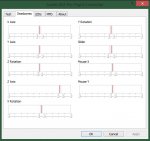I think I am, yes.
Which of the binds would you say are "questionable," though?
edit: The "missing" or "hidden" 17 through 30 buttons make me wonder if there's some way to actually have the mode switch change the button IDs. After all, Direct Input does support up to 128 buttons on one device.
Ok, here's my approach.
Grab yourself a blank piece of paper and start with the game setup for mouse/kb flight.
Go through the game options rebinding stuff as you see fit and noting down which keys trigger which functions. You are NOT aiming for decent ergonomics here, you are aiming for the keys you select for each function being memorable. This is because if you use any macros, it's possible for the stick to get "out of sync" with the game - you need to be able to remember which key has which function so that you can toggle it from the keyboard to bring the game back in sync with the stick.
Now close the game and look down the list of functions you've just mapped. Start planning which functions you want where on the stick, what combinations of them you might want as macros. Sit there with your hands on the stick thinking it over for a few minutes. Decide how you will use the modes - I personally for ED use mode 1 for landing, mode 2 for regular flight and mode 3 for combat - the mode switch acts as a combined landing gear toggle and "master arm" switch. I will assume a similar choice when giving examples below.
Now fire up the sticks profiling software. In the default profile, you'll see 6 shift states. One with and one without the pinkie shift in each mode. To release the pinkie switch to be a "real" button, delete the shift states that use the pinkie switch. To release the clutch button to be a "real" button disable clutch functionality in control panel.
Start by naming the modes for how you intend to use them - the name will show up on the sticks MFD when that profile is active. It's a small thing but it makes a difference. Now pick the mode you'll be spending most time in (for me mode 2 - flight mode) and set the others to have that mode as their fallback state.
Now start binding the keystrokes to the buttons. Start with the mode you selected as the fallback. Forget about the mouse nub controlling the pointer, it's useless for that. Configure both axes for bands with boundaries at 33%/66% so it effectively becomes an extra 4-way hat. In ED for me it's how I navigate the cockpit UI. Map every button you want to be a single function in-game to the keystroke you bound it to as a "simple command". Where you've got an option in-game to use an axis for a particular control and intend to, leave it unprogrammed in the profiling software. You'll bind that in-game.
Now macros. You've already planned which ones you want, right? These are "advanced commands" and can carry different key sequences for press/hold/release. The most useful place for these are the commands associated with mode switching because you set one macro for entering the mode in the "press" section, leave "hold" empty (unless you WANT a continuous sequence of commands repeating while you're in that mode) and use the "release" section for commands you want to trigger on exiting that mode. For example, here's what mine do:
Mode 1 - landing
press: Toggle landing gear, toggle lights, balance power, power to shields, power to shields, power to engines, power to shields, power to engines, power to shields (leaves me with two in engines and 4 to shields, none to weapons)
hold: nothing
release: toggle landing gear, toggle lights
Mode 2 - flight
press: balance power, power to engines, power to engines, power to shields, power to engines, power to shields, power to engines (sets 4 pips engines, 2 shields, none weapons)
hold: nothing
release: nothing
Mode 3 - combat
press: toggle hardpoints, balance power
hold: nothing
release: toggle hardpoints.
The important thing to remember when setting macros for mode switching is that the "release" action for the mode you are leaving will always precede the "press" action for the mode you are switching to. Pay attention to the "macro" checkbox so that it actually operates as a sequenced macro, not a bunch of simultaneous keypresses. for "press" actions it defaults to on, for "release" actions it defaults to off. Quantize the macro actions to 0.05sec so your macros execute as fast as possible but not too fast for the game to recognize.
Other buttons where you want macros to operate, set only a "press" action.
Finally, configure your bindings for the other two modes only where you want them to be different from the fallback - for example, in my fallback, mode2 my trigger and fire button activate chaff and SCB respectively, but when I roll up into combat mode (3) those move to where in flight mode I map SC and Jump - because I can't use those with hardpoints deployed anyway and the trigger and fire buttons become primary and secondary fire.
Save your profile, profile the stick from within the programming software and fire up the game. Bind your axes and test. switch back to the profiling software and make any adjustments you need to the sticks keystrokes and macros.
And to answer your q, the most "questionable" binding in the default X52 setup for ED is indeed the redundancy between using the precision slider AND the scroll wheel for scanner range. I unbound the scroll wheel from that and instead made scroll up/down cycle forward and backwards through my targets subsystems by keystroke.

